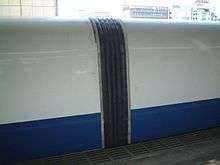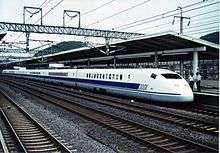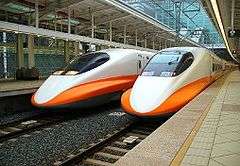300X
| Class 955 "300X" | |
|---|---|
|
Preserved car 955-6 at Hamamatsu Works, July 2010 | |
| In service | 1994–2002 |
| Manufacturer | Hitachi, Kawasaki Heavy Industries, Mitsubishi Heavy Industries, Nippon Sharyo |
| Constructed | 1994 |
| Scrapped | 2002 |
| Number built | 6 vehicles |
| Number in service | None |
| Number preserved | 2 vehicles |
| Number scrapped | 4 vehicles |
| Formation | 6 cars |
| Fleet numbers | A0 |
| Operator(s) | JR Central |
| Depot(s) | Tokyo |
| Line(s) served | Tokaido Shinkansen |
| Specifications | |
| Car body construction | Aluminium alloy |
| Car length |
27,150 mm (89 ft 1 in) (end cars), 25,000 mm (82 ft 0 in) (intermediate cars)[1] |
| Width | 3,100 mm (10 ft 2 in) |
| Height | 3,300 mm (10 ft 10 in) |
| Maximum speed | 350 km/h (217 mph) (nominal) |
| Traction system |
500 kW (670 hp) motors (4 per car) |
| Power output | 12 MW (16,000 hp) |
| Electric system(s) | 25 kV AC, 60 Hz |
| Current collection method | Overhead catenary |
| Track gauge | 1,435 mm (4 ft 8 1⁄2 in) |
"300X" was the name given to the Class 955 (955形) 6-car experimental Shinkansen train developed in 1994 by the Central Japan Railway Company (JR Central) in Japan to test technology to be incorporated in future shinkansen trains operating at speeds of 300 km/h (186 mph) or higher.[2]
Design
Manufacture of the train was shared among four different manufacturers, with a number of different body construction methods used. The two ends cars employed differing nose designs, and a number of pantograph shroud designs were tested over the lifetime of the trainset.[2]
Formation
| Car No. | 1 | 2 | 3 | 4 | 5 | 6 |
|---|---|---|---|---|---|---|
| Designation | Mc | M | M | M | M | Mc |
| Numbering | 955-1 | 955-2 | 955-3 | 955-4 | 955-5 | 955-6 |
| Weight (t) | 36 | 36 | 36 | 32 | 36 | 36 |
Cars 2 and 5 were fitted with pantographs.[3]

955-1
End car with "cusp" nose design, built by Mitsubishi Heavy Industries. The body was constructed of rivetted Duralumin. This car had no passenger seats.[1][2]
955-2
The body was constructed by Nippon Sharyo using large hollow aluminium extrusions. This was the only car in the trainset to be fitted with passenger seats.[2]
955-3
This vehicle was constructed by Kawasaki Heavy Industries using spot-welded large aluminium extrusions, and was fitted with active tilting.[2]
955-4
This vehicle was constructed by Nippon Sharyo using large hollow aluminium extrusions, similar to car 2, and was equipped with large side doors for installing and removing test equipment.[1]
955-5
This vehicle was constructed by Hitachi using aluminium honeycomb panels. This car had no seats.[1][2]
955-6
Hitachi-built end car with "wedge" nose design. The body was constructed of brazed aluminium honeycomb panels.[1]
History

The train was unveiled on 22 December 1994.[4]
Test-running on the Tokaido Shinkansen was delayed by track damage caused by the Great Hanshin earthquake in January 1995, but full-scale test-running commenced on 25 May 1995, between Maibara and Kyoto.[4]
On 21 September 1995, the Class 955 train recorded a maximum speed of 354.1 km/h (220.0 mph) on the Tokaido Shinkansen between Maibara and Kyoto.[5]
On 11 July 1996, the train recorded a maximum speed of 426.6 km/h (265.1 mph), exceeding the previous national speed record of 425.0 km/h (264.1 mph) set in December 1993 by JR East's Class 952/953 "STAR21" experimental train.[5]
On 26 July 1996, the train recorded a Japanese national speed record of 443.0 km/h (275.3 mph) on the Tokaido Shinkansen between Maibara and Kyoto.[3] This record still stands.
The Class 955 trainset was officially withdrawn on 1 February 2002.[6]
Preservation
End car 955-1 is preserved outdoors at the RTRI large-scale wind tunnel test facility in Maibara, Shiga.[7] End car 955-6 was initially preserved inside JR Central's Hamamatsu Works, and was moved to the new SCMaglev and Railway Park in 2010.[8]
-

Car 955-1 preserved at Maibara, July 2006
-
Car 955-6 preserved at Hamamatsu Works, July 2006
-

Car 955-6 preserved at the SCMaglev and Railway Park in Nagoya, June 2011
References
| Wikimedia Commons has media related to Class 955 "300X". |
- 1 2 3 4 5 JR全車輛ハンドブック2001 [JR Rolling Stock Handbook 2001]. Japan: Neko Publishing. 2001. ISBN 4-87366-723-2.
- 1 2 3 4 5 6 プロトタイプの世界 - Prototype World (in Japanese). Japan: Kotsu Shimbunsha. December 2005. pp. 60–63. OCLC 170056962.
- 1 2 JR電車編成表 '98夏号 [JR EMU Formations - Summer 1998]. Japan: JRR. July 1998. p. 99. ISBN 4-88283-029-9.
- 1 2 Suda, Hiroshi (2000). 東海道新幹線 [Tokaido Shinkansen]. Tokyo, Japan: JTB Can Books. ISBN 4-533-03563-9.
- 1 2 Semmens, Peter (1997). High Speed in Japan: Shinkansen - The World's Busiest High-speed Railway. Sheffield, UK: Platform 5 Publishing. ISBN 1-872524-88-5.
- ↑ 新幹線電車データブック2011 [Shinkansen Databook 2011]. Japan: JRR. March 2011. p. 95. ISBN 978-4-330-19811-8.
- ↑ 鉄道のテクノロジーVol1:新幹線 [Railway Technology Vol.1: Shinkansen]. Japan: Sanei Mook. April 2009. p. 122. ISBN 978-4-7796-0534-5.
- ↑ JR東海博物館(仮称)建物内への展示車両の搬入について [Installation of exhibits in JR Central Museum] (pdf) (in Japanese). JR Central. 21 July 2010. Retrieved 10 March 2011.




